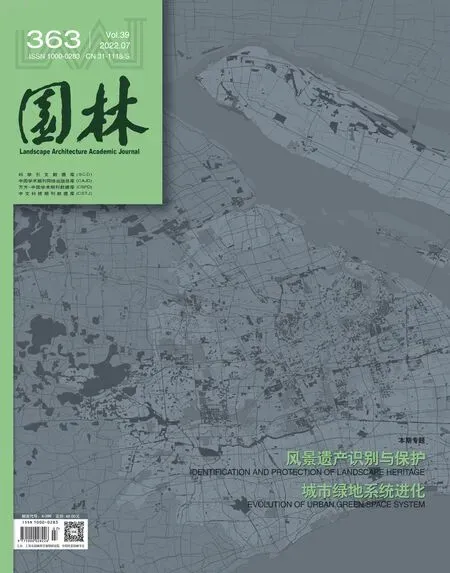风景遗产的价值与保护
2022-07-21张浪
2022年是联合国教科文组织第17届大会通过《保护世界文化和自然遗产公约》(以下简称《公约》)50周年,也是我国加入《公约》37周年。《公约》规定了文化遗产和自然遗产的定义,基于此,我国“风景遗产”的概念是顺应《公约》价值趋向前提下,进一步结合我国研究实际,在风景园林学科体系下进行的界定。风景遗产是具有国家或世界突出普遍价值的地域空间综合体,包括但不限于具有自然科学价值、自然美学价值、历史文化价值。风景遗产具有不可再生的特殊价值和性质,《公约》中对于遗产“突出普遍价值”的不断强调,使其不仅成为风景遗产评定的标准和根据,也成为风景遗产独特性、稀缺性、公共性、持续性等价值特质的高度概括。
习近平总书记指出:“历史文化遗产不仅生动述说着过去,也深刻影响着当下和未来;不仅属于我们,也属于子孙后代。保护好、传承好历史文化遗产是对历史负责、对人民负责。”笔者认为,遗产识别评估标准,是遗产差别化保护前提基础,以保证其确实是值得保护的遗产,而不是所有老旧的东西都能成为遗产;在分类分级的基础上,体现其永续价值及其当代价值,才是遗产保护的有效途径;故之,研究实施“活化利用”,才是遗产保护的关键。不管是城市风景遗产,还是传统村落(尤其是少数民族村落)风景遗产,都可以串联起人与地方的历史记忆和精神联系、塑造出属于地方特色的景观风貌、增强民族自信心和文化认同感,更是在地文化不可分割的一部分。
本期专题1“风景遗产识别与保护”,聚焦城乡聚落景观遗产、文化廊道景观遗产,研讨了城市风景遗产集群的保护策略、传统村落的景观意象、聚落空间特征识别及景观基因信息链的构建等内容。研究区域多分布于中国少数民族集中的西南地区,不同民族文化传统在此不断地碰撞、融合、进化,在漫长的人与自然相处过程中,形成“村融地中,天人共美”的深刻内涵。专题2“城市绿地系统进化”则研讨了城市更新发展背景下,城市绿地系统已进入总体结构完善阶段;蓝绿空间融合发展是事半功倍的科学发展途径,已经成为改善我国城市生态环境、提升城市功能的有力抓手。蓝与绿的融合,不仅可有效地增加滨水公共开放空间,更能有效地提升水岸带、交错带的生物多样性及其生态服务功能。本期两个专题的研讨,进一步拓展了国土空间规划“多规合一”大背景下,风景遗产价值识别与保护、城市绿地系统空间可持续发展等重要研究视角。
在倡导文化自信背景下,遗产保护和利用研究已成为当前人居环境学科中的重要理论与实践研究方向。我国是风景遗产资源大国,又处于城镇化快速发展的历史进程中,城乡协同的遗产保护工作依然任重道远。从风景遗产保护利用研究出发,归纳风景遗产营建智慧和当代应用价值,总结出适应我国文化背景下的风景遗产保护利用方法,才能以风景遗产为载体讲好中国故事。
主编
2022年6月6日
The Value and Protection of Landscape Heritage
The year 2022 marks the 50th anniversary of the CCPWCNH (Convention Concerning the Protection of the World Cultural and Natural Heritage) by the 17th General Conference of UNESCO and the 37th anniversary of China’s accession to the Convention.This Convention stipulated the defniitions of cultural heritage and natural heritage. Based on this, the concept of “landscape heritage” in China was defnied under the discipline system of landscape architecture in line with the value trend of the Convention. Landscape heritage is a regional space complex with national or world outstanding universal value, including but not limited to natural scientifci value, natural aesthetic value, and historical and cultural value.Landscape heritage has a special value and nature that is not renewable. The continuous emphasis on the “outstanding universal value” of heritage in the Convention makes it not only the standard and basis for the assessment of landscape heritage, but also a high-level summary of the uniqueness, scarcity, publicity, sustainability and other characteristics of landscape heritage.
General Secretary Xi Jinping pointed out: “Historical and cultural heritage not only vividly describes the past, but also profoundly affects the present and the future. It belongs not only to us, but also to future generations. Protecting and inheriting historical and cultural heritage is responsible for history and the people.” The author believes that the heritage identifciation and evaluation criteria are the premise and basis for the differential protection of heritage, so as to ensure that it is indeed a heritage worthy of protection, not that all old things can become heritage. On the basis of classifciation and grading, the effective way of heritage protection is to refelct its sustainable value and contemporary value. Therefore, the research and implementation of “activation and utilization” is the key to heritage protection.Whether it is urban landscape heritage or traditional village (especially minority village)landscape heritage, it can connect the historical memory and spiritual connection between people and places, shape the landscape with local characteristics, and enhance national self-confdience and cultural identity. It is an integral part of local culture.
The topic 1 of this issue, “Identifciation and Protection of Landscape Heritage”, focuses on urban and rural settlement landscape heritage and cultural corridor landscape heritage. The protection strategies of urban landscape heritage clusters, the landscape image of traditional villages, the identifciation of settlement space characteristics, and the integration of landscape genetic information chains were discussed. The research area is mostly distributed in the southwestern region where ethnic minorities are concentrated in China. The cultural traditions of different ethnic groups are constantly colliding, merging, and evolving here. In the long process of coexisting with nature, the profound connotation of “Harmony between the village and the earth, and beauty between heaven and man” has been formed. Topic 2“Evolution of Urban Green Space System” discusses that under the background of urban renewal and development, the urban green space system has entered the stage of overall structural improvement. The integrated development of blue-green space is a scientific development approach that achieves twice the result with half the effort. The integration of blue and green can not only effectively increase the waterfront public open space, but also effectively enhance the biodiversity and ecological service functions of the waterfront and interlaced zones. The discussion of the two topics further expands the important research perspectives such as the identifciation and protection of landscape heritage value, and the sustainable development of urban green space system space under the background of“multi-planning integration” of national land and space planning.
Under the background of advocating cultural self-confdience, heritage protection and utilization research has become an important theoretical and practical research direction in the current human settlements discipline. China is a country with a large number of landscape heritage resources, and is in the historical process of rapid urbanization. The urban-rural coordinated heritage protection work still has a long way to go. From the perspective of the protection and utilization of landscape heritage, summarizing the construction wisdom and contemporary application value of landscape heritage, and summarizing the protection and utilization methods of landscape heritage under the cultural background of our country, can we use landscape heritage as a carrier to tell Chinese stories well.
